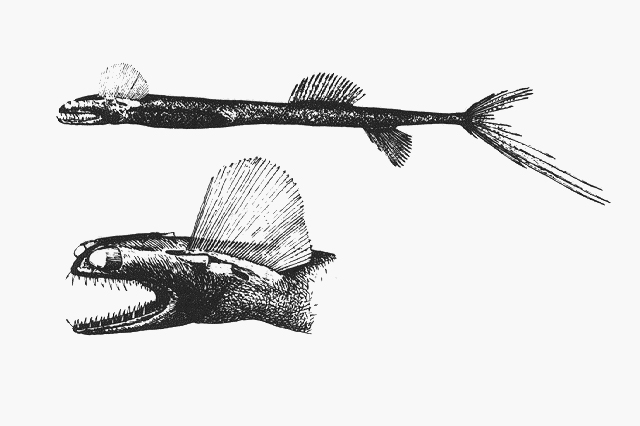Indian Telescopefish, Gigantura indica (Brauer 1901)
Other Names: Lisa's Pacific Telescope Fish, Pacific Telescopefish, Telescopefish

Illustration of an Indian Telescopefish, Gigantura indica. Source: South African Institute of Aquatic Biology / FishBase. License: All rights reserved
Summary:
A deep-sea predator with a scaleless silvery body, unusual forward-directed tubular eyes with very large lenses, and a long ribbon-like tail. Telescopefishes swim vertically in the water column, using their huge eyes to detect silhouettes of prey above.
Amazing footage of a pair of Indian Telescopefish filmed by MBARI’s ROV Tiburon at 1214 m during an expedition to the Hawaiian Islands in 2001 - showing that they orientate themselves vertically in the water column.
Amazing footage of a pair of Indian Telescopefish filmed by MBARI’s ROV Tiburon at 1214 m during an expedition to the Hawaiian Islands in 2001 - showing that they orientate themselves vertically in the water column.
Cite this page as:
Bray, D.J. 2017, Gigantura indica in Fishes of Australia, accessed 04 Jul 2025, https://fishesofaustralia.net.au/Home/species/2788
Indian Telescopefish, Gigantura indica (Brauer 1901)
More Info
|
Distribution |
North of Port Hedland, Western Australia, and off north Queensland; also ENE of Norfolk Island in the Tasman Sea. Elsewhere the species is widely distributed in the Atlantic, Indian and Pacific Oceans, mostly between 30ºN and 30ºS. Adults inhabit mesopelagic and upper bathypelagic zones, while the larvae are epipelagic mostly in depths between 30-170 m. |
|
Feeding |
Meso-/bathypelagic predators that swim vertically, head up, in the open ocean. They use their its huge forward-directed eyes to detect the silhouettes of prey swimming above. Telescopefishes have reduced skeletal elements enabling them to engulf fishes much larger than themselves. |
|
Biology |
Telescopefishes are synchronous hermaphrodites, and have an extended larval stage in epipelagic waters prior to metamorphosis. |
|
Species Citation |
Gigantura chuni indica Brauer, A. 1901. Sitzungsberichte der Gesellschaft zur Beförderung der Gesamten Naturwissenschaften du Marburg 8: 129. Type locality: north-west of Chagos Island, Indian Ocean. |
|
Author |
Bray, D.J. 2017 |
|
Resources |
Indian Telescopefish, Gigantura indica (Brauer 1901)
References
Bannermann, P., Nunoo, F., Poss, S. & Russell, B. 2015. Gigantura indica. The IUCN Red List of Threatened Species 2015: e.T190180A15603010. http://dx.doi.org/10.2305/IUCN.UK.2015-4.RLTS.T190180A15603010.en. Downloaded on 23 December 2016.
Brauer, 1901. Über einige von der Valdivia-Expedition gesammelten Tiefseefische und ihre Augen. Sitzungsberichte der Gesellschaft zur Beförderung der Gesamten Naturwissenschaften du Marburg 8: 115-130 figs 1-3
Johnson, R.K. 1986. Giganturidae. p. 273-274. In M.M. Smith & P.C. Heemstra (eds) Smiths' sea fishes. Springer-Verlag, Berlin.
Johnson, R.K. & Bertelsen, E. 1991. The fishes of the family Giganturidae: systematics, distribution and aspects of biology. Dana Report, Carlsberg Foundation 91: 1-45.
Konstantinidis, P. & Johnson, G.D. 2016. Osteology of the telescopefishes of the genus Gigantura (Brauer, 1901), Teleostei: Aulopiformes. Zoological Journal of the Linnean Society DOI: 10.1111/zoj.12469 PDF Open access
Paxton, J.R. & Niem, V.H. 1999. Families Paralepididae, Anotopteridae, Evermannellidae, Omosudidae, Alepisauridae, Giganturidae. pp. 1948-1954 in Carpenter, K.E. & Niem, V.H. (eds). The Living Marine Resources of the Western Central Pacific. FAO Species Identification Guide for Fisheries Purposes. Rome : FAO Vol. 3 pp. 1397-2068.
Regan CT. 1925. The fishes of the genus Gigantura, A. Brauer, based on the specimens collected in the Atlantic by the ‘Dana’ Expeditions, 1920–22. Annals and Magazine of Natural History 15: 53–59. (described as Gigantura gracilis)
Tucker, D.W. 1954. Report on the fishes collected by S. Y. "Rosaura" in the North and Central Atlantic, 1937-38. Part I. Families Carcharhinidae, Torpedinidae, Rosauridae (nov.), Salmonidae, Alepocephalidae, Searsidae, Clupeidae. Bulletin of the British Museum (Natural History) Zoology 2(6): 163-214, Pls. 7-8. Ref available at BHL (described as Rosaura rotunda)
Walters, V. 1961. A contribution to the biology of the Giganturidae, with description of a new genus and species. Bulletin of the Museum of Comparative Zoology 125(10): 295-319 Ref available at BHL (described as Bathyleptus lisae)



